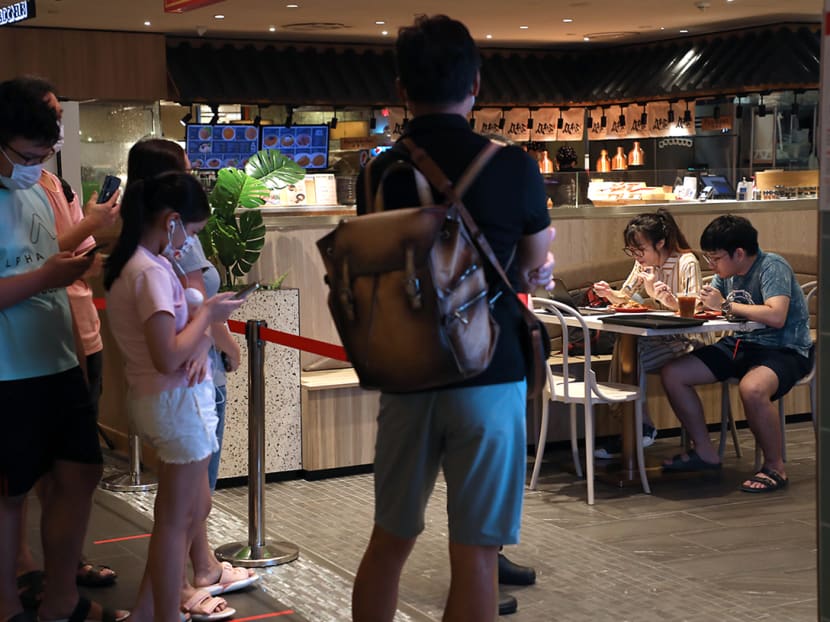Community testing still shows high Covid-19 infection rate, S’pore nowhere near peak of epidemic curve: MOH
SINGAPORE — Covid-19 testing in the community for those who go to clinics with acute respiratory infections or flu-like illnesses continues to detect a high proportion of infections, suggesting that Singapore is “not anywhere near the peak of the epidemic curve yet, nor are the community cases yet on the wane”.
- Community testing for Covid-19 is still turning up a high proportion of infections
- This suggests Singapore is “not anywhere near the peak of the epidemic curve”, said the health ministry’s medical services director
- Even with the move to rely more heavily on antigen rapid tests, the Govt will continue reporting daily case counts for now
- But it will move progressively to focus on the numbers of those needing more medical care
SINGAPORE — Covid-19 testing in the community for those who go to clinics with acute respiratory infections or flu-like illnesses continues to detect a high proportion of infections, suggesting that Singapore is “not anywhere near the peak of the epidemic curve yet, nor are the community cases yet on the wane”.
Making this point on Saturday (Oct 9), Associate Professor Kenneth Mak, who is director of medical services at the Ministry of Health (MOH), added that the coronavirus is still spreading in settings where people are gathering and engaging in mask-off activities such as when they dine out together.
Still, the doubling cycle of community infections has lengthened to about 12 days, Assoc Prof Mak stressed again, adding that MOH hopes the existing coronavirus curbs would help slow the rise in community cases further.
Of the 2,825 cases in the community detected on Friday, about 35 per cent were picked up from people showing symptoms at clinics that test such individuals.
Another 15 per cent were detected in people under quarantine and 6 per cent was found through routine tests for those at higher risk of catching Covid-19.
The remaining were those who received health risk warnings or alerts for coming into contact with Covid-19 cases, and others have yet to be characterised properly.
DAILY REPORTING OF CASES
At a press conference by the national Covid-19 task force on Saturday, it was announced that Covid-19 polymerase chain reaction (PCR) swab tests — which presently contribute to Singapore’s daily coronavirus count — would be reserved primarily for those who show symptoms and are unwell, and antigen rapid tests would be used for those who are well.
Yet, even with this move, Assoc Prof Mak said that the Government would continue reporting daily case counts for now but would move progressively to focus on the numbers involving those who require greater medical care because of Covid-19.
These include patients with other high-risk factors who may end up in hospitals or treatment facilities, and need oxygen support to breathe or intensive care.
“We will progressively focus a lot more on these numbers because these are the people who have more severe infection that do require more care and utilisation of our healthcare resources, and we need to invest a lot more to making sure they have as best an outcome as possible,” he said in response to a question from TODAY.
The authorities, he added, will rely on various indicators that could go beyond PCR test results and reports.
Community surveillance, for instance, allows a better grasp of the prevalence of Covid-19, how it is spreading and whether it is resulting in clusters forming.
Singapore is in the midst of a wave of infections driven by the highly contagious Delta variant of the coronavirus. New daily cases have surpassed 3,000 since Tuesday, with a record 3,590 infections registered on Friday.
MOH on Saturday said that 98.8 per cent of Covid-19 patients continue to have mild or no symptoms.
This is on account of Singapore’s high vaccination coverage, with 83 per cent of the population having completed their double-dose regimen, it said in a press statement.
Of the 423 cases with severe illness in the last two weeks, 53.9 per cent were not immunised against Covid-19, and the rest were vaccinated individuals with co-morbidities — two or more health conditions.
Health Minister Ong Ye Kung, the task force co-chair, said that the highest risk continues to rest with unvaccinated people aged 60 and older, as well as all who are aged 80 and above.
Assoc Prof Mak stressed again that unvaccinated persons are up to 14 times more likely to develop severe illness from Covid-19 than those who are inoculated.
MOH said that the number of persons needing intensive care is continuing to rise at the same rate as overall case numbers, though with a lag.
Fifty-one new cases have been admitted to intensive care units over the past two weeks, compared with 32 in the two weeks before that.
“Although we have increased our hospital capacity, bed occupancy rates are rising, and our healthcare manpower has been stretched,” MOH said.
Right now, there are more than 180 beds for Covid-19 patients needing intensive care, and Assoc Prof Mak said that the authorities are prepared to add 100 beds in the next few weeks if needed.
.embed-container { position: relative; padding-bottom: 56.25%; height: 0; overflow: hidden; max-width: 100%; } .embed-container iframe, .embed-container object, .embed-container embed { position: absolute; top: 0; left: 0; width: 100%; height: 100%; }






